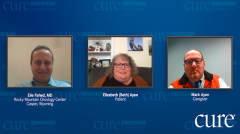
Triple-Class Refractory Multiple Myeloma Improves With New Therapy
Beth describes her journey after treatment failure for triple-class refractory multiple myeloma, as well as improvement due to a new therapy.
Episodes in this series

Elie Fahed, MD: Tell us about what symptoms you were having and where your disease was at this time.
Elizabeth Ayen: The tumor on my sternum was continuing to grow. I think we measured it at 4 inches by 3 inches by 3 inches at that time, so it was large. I was having more lesions happening in my ankles, so I was back to having more radiation there. I had developed a tumor in my orbital bone that was causing my eye to be pressed down and out. It was going back into my brain a bit, pushing on the brain. Things were not progressing the way we wanted.
Elie Fahed, MD: Things were getting out of control, correct?
Elizabeth Ayen: Yes.
Elie Fahed, MD: Kind of.
Elizabeth Ayen: Yes.
Elie Fahed, MD: Alright. At that time, we had a discussion about a new regimen. It’s a combination of bortezomib, selinexor, and dexamethasone. I remember it wasn’t approved by the FDA at that time as a combination. The BOSTON trial data were out. We got you started, and it was within a week of starting it that they approved the combination.
Let me explain what selinexor is. It’s a new product here. It is an oral selective inhibitor of nuclear export [SINE]. It inhibits nuclear export and starts increasing tumor-suppressor proteins inside the nucleus, causing apoptosis and death of the cells. It’s approved for use, and the setting is single agent in combination with dexamethasone. More recently, it’s approved for the second line of therapy and beyond in combination with bortezomib and Decadron [dexamethasone]. We started around November 2020. Tell us how you did for the first week or two.
Elizabeth Ayen: As soon as we went on that regimen, within the first week, I could tell that the tumor was starting to dissipate some. After two weeks, it was almost completely gone. You couldn’t see it anymore; you could barely palpate it, and I was starting to feel better. I was getting stronger, and I felt like I could do more things, and I had the desire to do them. There are some side effects with it. There is still some fatigue, and my platelets and white blood cell counts were a little lower, but other than that, I feel so much better. My light chains dropped dramatically.
Elie Fahed, MD: I remember you chatting with the chemotherapy nurses at the time. Within two weeks, that 4-inch mass you could feel was completely gone, and I’m not sure if they believed you.
Elizabeth Ayen: I know. Everybody kept coming over to feel it because they were so amazed because before you could actually see it. They were saying things like, “You can’t see it anymore,” and they all wanted to come over and touch it, so it was pretty cool.
Elie Fahed, MD: Then clinically, we wanted to confirm that response. We would check your serum free light chains, and it was about a 90% drop within two weeks.
Elizabeth Ayen: Yes. It went from 70 [mg/L] down to about 25, and then from 25 down to 0.2.
Elie Fahed, MD: That’s an impressive response.
Elizabeth Ayen: Yes.
Elie Fahed, MD: What kind of side effects did you have from this regimen?
Elizabeth Ayen: There is some fatigue, and a bit of nausea, for which I’ve been taking the nausea medication, as well as a little bit of lack of appetite. Other than that, like I said, I feel so much stronger and so much better, wouldn’t you say, Mark?
Mark Ayen: Yes. It’s been pretty dramatic with this latest treatment. The most dramatic thing was, I was trying to remember, we actually named the tumor on her chest.
Elie Fahed, MD: I didn’t know that. Alright, would you want to share it?
Mark Ayen: I don’t remember. Do you remember what we named it?
Elizabeth Ayen: No.
Mark Ayen: I don’t remember what it was, but we named it because it had become such a part of who she was. In literally two or three weeks, it was gone, and she has felt a lot better. It’s also been weird because all this stuff happened during the whole COVID-19 reality. Beth was staying home most of the time anyway because we were trying to protect her because her platelets, white blood cell counts, and all that stuff was low. But she has just seemed better.
Elie Fahed, MD: She felt better.
Mark Ayen: She felt better, yes. She felt more like she wanted to do stuff. We could do puzzles, play games, and do the kind of stuff that she hadn’t felt like doing in maybe two years.
Elie Fahed, MD: Now she wants to go on vacation.
Elizabeth Ayen: That’s right.
Elie Fahed, MD: She wants to travel.
Mark Ayen: She wants to see the grandkids.
Elie Fahed, MD: You can travel. I may not have shared this with you, but I was really concerned about you when that mass kept growing and it was technically refractory to the prior treatment. I’m pleased that we were able to find a regimen to control it. You’re technically in remission now.
In terms of side effects of this regimen, we see some cytopenias, as you mentioned. Your platelets and white cells are low. In your case, nausea was not a big deal. For others, it can be a significant side effect requiring preventive therapy, so I recommend other patients being on top of their nausea medications if they are to try this medication. As we can see, it can be very effective in a very refractory type of disease, and we will continue as long as it’s working.
This transcript has been edited for clarity.
